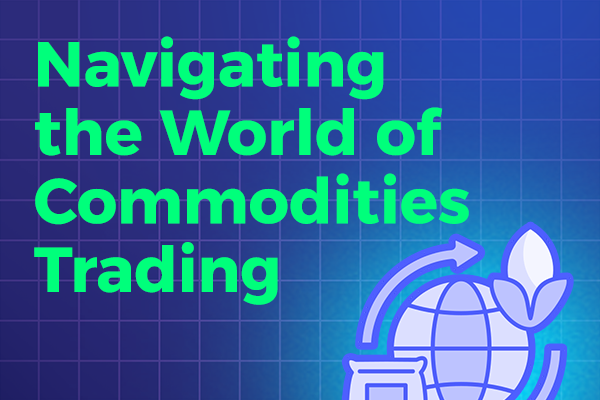Commodities trading can be a complex world to navigate, with a variety of different types of commodities and trading strategies to consider. However, with the right knowledge and understanding, it can also be an exciting and lucrative field to explore.
In this guide, we’ll take a closer look at the different types of commodities trading, from agricultural products like wheat and corn to precious metals like gold and silver. We’ll explore the various factors that can impact commodity prices, as well as the different trading strategies that traders can employ to maximize their profits.
Whether you’re a seasoned trader looking to expand your knowledge or a beginner just starting out in the world of commodities trading, this guide will provide you with the information you need to make informed decisions and succeed in this dynamic and ever-evolving market.
So, let’s dive in and explore the world of commodities trading together!
Understanding the Different Types of Commodities
Commodities are raw materials or primary agricultural products that can be bought and sold. Commodities trading can be done in two ways – physical trading and trading futures contracts.
Physical trading involves the buying and selling of actual commodities, while trading futures contracts involves buying or selling a contract that represents the right to buy or sell a specific commodity at a future date.
Physical Commodities vs. Futures Contracts
Physical commodities are actual goods that are bought and sold in the market. Agricultural commodities like grains, livestock, and dairy products are examples of physical commodities.
On the other hand, futures contracts are financial instruments that represent the right to buy or sell a specific commodity at a future date. Futures contracts are used by traders to speculate on the future price of a commodity and to hedge their risks.
Agricultural Commodities – Grains, Livestock, and Dairy
Agricultural commodities are among the most traded commodities in the market. They include grains like wheat, corn, and soybeans, livestock like cattle, hogs, and poultry, and dairy products like milk and cheese.
The prices of agricultural commodities are impacted by a variety of factors including weather conditions, demand and supply, and government policies.
Grains like wheat, corn, and soybeans are important commodities as they are used in the production of various food items. Wheat is used to make bread, while corn is used in the production of ethanol, animal feed, and food products.
Soybeans are used to produce soybean oil and soybean meal, which are used in food products and animal feed.
Livestock commodities like cattle, hogs, and poultry are used for meat production. The prices of livestock commodities are influenced by factors such as demand and supply, weather conditions, and government policies.
Dairy products like milk and cheese are important commodities that are used in the production of various food items. The prices of dairy products are influenced by factors such as demand and supply, weather conditions, and government policies.
Energy Commodities – Crude Oil, Natural Gas, and Gasoline
Energy commodities are among the most traded commodities in the market. They include crude oil, natural gas, and gasoline. Crude oil is the most actively traded commodity, and its price is influenced by a variety of factors including global demand and supply, geopolitical tensions, and weather conditions.
Natural gas is another important energy commodity, and its price is influenced by factors such as demand and supply, weather conditions, and government policies. Gasoline is a refined product of crude oil, and its price is influenced by the price of crude oil and demand and supply.
Unlock Wealth: Sign Up Now for Smart Investing Success
Precious Metals – Gold, Silver, and Platinum
Precious metals like gold, silver, and platinum are highly valued for their rarity and beauty. They are also used in the production of jewelry, electronic devices, and other industrial products.
The prices of precious metals are influenced by a variety of factors including global demand and supply, geopolitical tensions, and economic conditions.
Gold
Gold is one of the most widely traded precious metals in the market. It is highly valued for its rarity and beauty, and is used in the production of jewelry, electronic devices, and other industrial products. The price of gold is influenced by a variety of factors, including global demand and supply, geopolitical tensions, and economic conditions.
Silver
Silver is another highly valued precious metal that is used in the production of jewelry, electronic devices, and other industrial products. The price of silver is influenced by factors such as global demand and supply, geopolitical tensions, and economic conditions.
Platinum
Platinum is a rare and valuable precious metal that is used in the production of jewelry, electronic devices, and other industrial products. The price of platinum is influenced by factors such as global demand and supply, geopolitical tensions, and economic conditions.
Investing in Commodities – Pros and Cons
Investing in commodities can be a good way to diversify your portfolio and potentially earn high returns. However, like any investment, there are pros and cons to investing in commodities.
Pros of Investing in Commodities
One of the main advantages of investing in commodities is that they have historically provided high returns. In addition, commodities can be a good way to diversify your portfolio and protect against inflation. Finally, investing in commodities can be a good way to hedge against geopolitical risks and other economic uncertainties.
Cons of Investing in Commodities
One of the main disadvantages of investing in all types commodities is the volatility of commodity prices. In addition, commodities can be affected by a variety of factors, including weather conditions, geopolitical risks, and economic conditions. Finally, investing in commodities can be more complex than investing in other asset classes, and requires a certain level of knowledge and expertise.
Commodities Trading Strategies
Commodities trading strategies can be divided into two broad categories – fundamental and technical analysis. Fundamental analysis involves analyzing economic and financial data to determine the underlying value of a commodity, while technical analysis involves using charts and other technical indicators to predict future price movements.
Fundamental Analysis
Fundamental analysis is based on the premise that the underlying value of a commodity can be determined by analyzing economic and financial data. This data can include factors such as supply and demand, weather conditions, and government policies. Traders who use fundamental analysis to trade commodities often focus on long-term trends and are more interested in the underlying value of a commodity than its short-term price movements.
Technical Analysis
Technical analysis is based on the premise that the price of a commodity can be predicted by analyzing charts and other technical indicators. Traders who use technical analysis to trade commodities often focus on short-term price movements and may use a variety of indicators such as moving averages, trend lines, and oscillators to identify potential trading opportunities.
Risks and Challenges of Commodities Trading
Commodities trading can be a lucrative field, but it also comes with risks and challenges. Some of the main risks and challenges of commodities trading include:
Market Volatility
Commodity prices can be highly volatile, and traders who are not prepared for sudden price movements can suffer significant losses.
Regulatory Risks
Commodities trading is subject to a variety of regulations, and traders who are not aware of these regulations can face significant legal and financial risks.
Geopolitical Risks
Commodity prices can be affected by geopolitical risks such as wars, political instability, and trade disputes.
Weather Risks
Commodity prices can be affected by weather conditions such as droughts, floods, and hurricanes.
Conclusion
Commodities trading can be a complex and challenging field, but it can also be an exciting and lucrative one for those who are prepared to put in the time and effort to master it.
By understanding the different types of commodities, the factors that can impact commodity prices, and the different trading strategies that traders can employ, you can make informed decisions and succeed in this dynamic and ever-evolving market.
Whether you’re a seasoned trader looking to expand your knowledge or a beginner just starting out in the types of commodities trading, this guide will provide you with the information you need to navigate the world of commodities trading with confidence.


